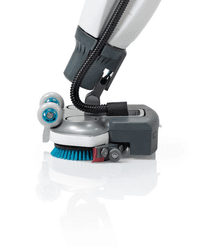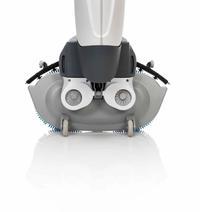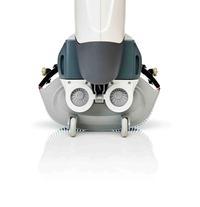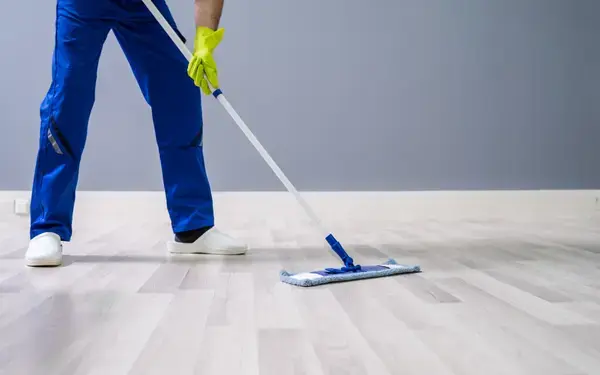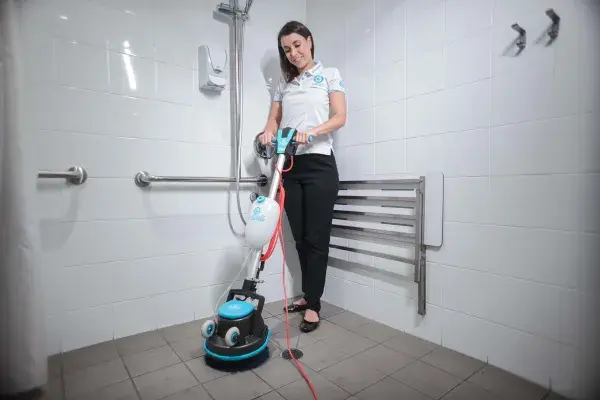You are reading: Best Floor Scrubbers for Aged Care Facilities in 2025
18 June 2025
15min read time
Brooke Payne
Best Floor Scrubbers for Aged Care Facilities in 2025
Share:

Key Insights
- Infection Control and Safety Are Critical: Aged care facilities must meet strict hygiene and safety standards. Floor scrubbers that dry quickly and prevent cross-contamination play a vital role in reducing infection risk and fall hazards.
- Equipment Must Suit Aged Care Needs: The best machines—like the i-mop XXL, i-mop Lite, and Co-botic 45—offer maneuverability in tight spaces, low noise levels, and ease of use for understaffed facilities, making them ideal for aged care environments.
- Compliance and Sustainability Matter: Choosing scrubbers that meet regulatory requirements and support water, energy, and chemical efficiency helps aged care providers stay compliant while also advancing sustainability goals.
Why Cleanliness in Aged Care Matters More Than Ever
It’s easy to overlook clean floors as just another part of daily operations—but in aged care, they’re absolutely essential.
2025 has brought with it heightened awareness of hygiene across the board. For aged care facilities, the stakes are even higher. With vulnerable residents and increasingly strict standards from regulatory bodies like the Aged Care Quality and Safety Commission, there's no room for shortcuts.
Healthcare-associated infections affect approximately 165,000 Australians annually, with aged care residents being particularly vulnerable due to compromised immune systems. More specifically, research shows that 170,574 HAIs occur in adults admitted to public hospitals in Australia annually, resulting in 7,583 deaths. The financial and human cost is significant—poor cleaning protocols can lead to serious health outcomes and compliance issues.
Facility managers and procurement officers are under pressure to find cleaning equipment that's not only effective, but also reliable, safe, and tailored to the nuances of aged care environments. The Aged Care Quality Standards explicitly require providers to demonstrate effective infection prevention and control systems, making equipment selection a compliance-critical decision.
The Fall Risk Connection
Falls present another critical safety concern in aged care. 1 in 4 people aged 65 and over have at least 1 fall per year, and this age group accounts for 60% of fall hospitalizations in Australia. According to the Australian Institute of Health and Welfare, 140,000 people over 65 years were admitted to hospital due to a fall in 2021-2022.
Floor cleaning equipment that leaves surfaces quickly dry and slip-resistant plays a crucial role in fall prevention—making equipment selection not just about cleanliness, but resident safety.
So the question becomes: what's the best floor scrubber for aged care in 2025?
What to Look for in Aged Care Cleaning Equipment
Before diving into the top machines, it's important to understand what separates a general-purpose scrubber from one that's truly suitable for aged care:
Maneuverability: Navigating around beds, chairs, and narrow hallways is non-negotiable. Standard Australian bedroom dimensions average 3.2m x 3.0m, requiring equipment that can clean effectively in tight spaces.
Low Noise Levels: Residents—many of whom are resting, unwell, or sensitive to sound—need peace and quiet. Equipment operating below 60 decibels helps maintain therapeutic environments.
User-Friendliness: Equipment must be easy to use across all shifts with minimal training. With aged care experiencing significant staff challenges—the sector faces an annual shortfall of 35,000 workers—simplicity reduces training costs and ensures consistent cleaning standards.
Hygiene-Centric Features: Dual water tanks prevent cross-contamination, colour-coded accessories enable zone-specific cleaning, and built-in filtration systems capture harmful particles.
Environmental Sustainability: Modern facilities prioritize water and chemical reduction. Advanced cleaning systems can significantly reduce resource consumption while maintaining hygiene standards.
With these criteria in mind, let's examine the best-in-class scrubbers for 2025.
The Best Floor Scrubbers for Aged Care Facilities in 2025
1. i-mop XXL
If there's one machine that consistently stands out across aged care environments, it's the i-mop XXL .
Where it works best: Communal areas,hallways, dining spaces
Technical Specifications:
- Battery life:50-60min with i-power 9, 60-70min with i-power 14 & 130min with i-power 20
- Scrub width: 62cm
- Water tank capacity: 5L clean, 8L recovery
- Weight without batteries: 21kg
- Drying time: Under 30 seconds (almost instantly)
- Theoretical performance: 2300 m2 per hour
Why it's aged care-ready:
- Lightweight and cordless design perfect for multi-floor facilities
- Operates quietly to avoid disrupting residents during day shifts or evening rest
- Deep-cleans more effectively than traditional mopping methods
- Fast-drying capabilities reduce slip hazards—critical for preventing falls among elderly residents
- Dual tank system prevents cross-contamination between clean and dirty areas
- Switch solutions fast with additional colour-coded tanks to suit your application - such as antibacterial solutions for bathrooms to chemicals for high-grease kitchen floors.
- Proven by objectively quantifiable ATP testing, our industrial floor mop creates surfaces that are 90% cleaner than traditional mopping methods.
Take a look at the video testimonial of the i-mop below in an aged care center.
2. i-mop Lite
The i-mop lite is a compact floor scrubber dryer designed for tight spaces.thei-mop Lite is the go-to for en-suites, small bedrooms, and bathrooms.
Where it works best: Bathrooms, tight corridors, compact spaces
Technical Specifications:
- Run time: 45 minutes continuous operation
- Cleaning width: 26cm
- Water tank capacity: 3L clean, 5L recovery
- Weight without batteries: 11.5kg
- Charge time: 6 hours
- Theoretical Performance: Up to 1400m² ph
Why it's aged care-ready:
- Ultra-compact design navigates around mobility aids, wheelchairs, and medical equipment
- Light construction reduces staff fatigue during long shifts
- Safe for quick clean-ups during the day without disrupting resident activities
- Minimal drying time reduces fall risks in high-traffic bathroom areas
- Ideal for multi-floor facilities where equipment must be transported via stairs or lifts
- Not every facility needs heavy-duty equipment in every area. The i-mop Lite provides agility without sacrificing cleaning power—perfect for spot cleaning or scheduled hygiene routines.
3. Co-botic45
The future is autonomous—and the Co-botic45 is leading the way in aged care applications.
Where it works best: Designed for hard floors ranging from 200m² to 1500m², the co-botic 45 is an intelligent robotic scrubber-dryer. It's not here to replace the human cleaner but rather to work alongside them.
Technical Specifications:
- Operating time: 2-3 hours autonomous operation
- Cleaning pressure: 2-6kg
- Navigation: LiDAR and camera-based mapping
- Tank capacity: 10L clean, 10L recovery
- Noise level:75 dB (power), 71 dB (standard), 65 dB (quiet)
- Integration: Compatible with facility management software
- Cleaning Efficiency: Up to 1500m²
Why it's aged care-ready:
- Autonomous cleaning saves valuable staff time for resident-focused activities
- Smart navigation technology automatically avoids residents, wheelchairs, and temporary obstacles
- Operates quietly in the background during visiting hours or activities
- Lets staff focus on high-touch surface sanitization and direct resident engagement
- Setting it up is a breeze. You can go from unboxing to operational in just 30 minutes, and from that point on, it's ready for daily use within 3 minutes. It's that simple.
- With the co-botic app, a custom map of the cleaning area can be generated. During the initial run, it memorizes each location, guaranteeing it maintains its path and doesn't overlook any area, even if the floor is temporarily occupied.
- With facilities losing 10,000 workers in one quarter and on track to lose 25% annually, according to Professor Denise Jepsen from Macquarie University, autonomous technology helps fill critical staffing gaps.
Safety, Compliance & Performance Monitoring
Compliance isn't optional in aged care. Facilities must regularly demonstrate adherence to strict infection prevention protocols outlined in the Aged Care Quality Standards, particularly Standard 3 (Personal Care and Clinical Care) and Standard 8 (Organisational Governance).
Essential Compliance Features
When assessing cleaning equipment, its best to ensure your machines meet these requirements:
Slip Resistance: Equipment must leave floors dry and safe within 30 seconds. Look for machines with adjustable suction power and dual-motor systems.
Infection Control Support: Dual tank systems prevent cross-contamination, colour-coded accessories enable zone-specific cleaning protocols, and equipment must be compatible with TGA-approved disinfectants.
Certification Requirements: Verify CE markings, IP ratings for electrical safety, water-saving certifications, and registration for commercial healthcare use.
Performance Benchmarking
Research demonstrates that with proper equipment and training protocols, cleaning rates can reach and maintain 93% effectiveness. Studies show this level of performance is associated with significant reductions in healthcare-associated infections—facilities achieving optimal cleaning saw a 75% reduction in overall hospital-acquired infection rates.
Workforce Challenges and Equipment Selection
The aged care sector faces unprecedented staffing challenges. Employment in residential care services increased by 39% from 216,000 to 301,000 people between 2014-2024, yet demand continues to outstrip supply. By having user-friendly machinery, staff can get the job done faster and better, with less user strain.
That's why equipment selection must account for:
- Training Simplicity: User-friendly machines reduce onboarding time from days to hours
- Physical Demands: Lightweight, ergonomic designs reduce staff fatigue and injury risk
- Versatility: Multi-purpose equipment maximizes utility across different cleaning tasks
- Reliability: Dependable machines reduce maintenance downtime and service disruptions
- Fun: Enhance user satisfaction while at work
Take a look at this in depth article here about the most common cleaning challenges in aged care.
Essential Questions Before Purchase
Before investing in a new floor scrubber, it’s worth asking the right questions to ensure you choose the equipment that truly fits your space, staff, and cleaning needs. Use the checklist below to help guide your decision-making process.
Facility Assessment:
What flooring types do we have (vinyl, timber, carpet, non-slip surfaces)?
What are our peak cleaning windows and frequency requirements?
How many staff members will use this equipment across different shifts?
Operational Considerations:
What's our budget for initial purchase and ongoing maintenance?
Do we have adequate storage and charging facilities?
What's the average drying time requirement for our resident traffic patterns?
Compliance and Safety:
- Does the equipment meet Australian healthcare facility standards?
- Can we demonstrate infection control protocols with this equipment?
- How does this equipment integrate with our existing cleaning procedures?
Supplier Evaluation:
- What training and ongoing support is provided?
- What's the warranty coverage and local service availability?
- Can we demo the equipment before final commitment?
By asking yourself and your team these questions, you can make a confident, well-informed investment in a floor scrubber that not only meets your immediate cleaning needs but also enhances long-term productivity, safety, and operational efficiency.
Take a read of this case study from Daniel, Maintenance Supervisor about using the i-mop in aged care.
Staff Training, Implementation & Maintenance: The Full Picture
Even the most advanced floor scrubber won’t deliver results without proper training and care. Aged care facilities that achieve the best outcomes invest in more than just the machine — they focus on smart implementation and long-term upkeep.
- Tailored Training Programs
Ensure cleaning staff are confident with equipment operation, maintenance routines, safety protocols, and quick fixes. - Inclusive Change Management
Involve the cleaning team early. When staff understand the value of the change, they’re more engaged and effective from day one. - Ongoing Support & Refresher Training
Regular check-ins and access to support help maintain consistency and prevent misuse over time. - Scheduled Servicing & Preventative Maintenance
Avoid unexpected downtime and extend the lifespan of your investment by sticking to a regular service schedule. Preventative care also supports compliance by ensuring optimal cleaning results every day. - Measurable Outcomes
Monitor cleaning times, audit results, and feedback from residents to assess performance and identify areas to improve.
Sustainability Matters: Choosing Environmentally Responsible Equipment for Aged Care
In 2025, aged care facilities aren’t just choosing floor scrubbers for performance — they’re also considering their environmental footprint. With increasing focus on sustainable operations, the best machines support green initiatives without compromising hygiene or safety.
Water-Saving Technology
Top-performing scrubbers use significantly less water than traditional cleaning methods — often cutting usage by up to 70%. This reduces costs and supports aged care commitments to sustainability.
Smarter Chemical Usage
Built-in precision dosing systems minimise waste and avoid overuse of harsh chemicals, protecting both the environment and the health of vulnerable residents.
Energy Efficiency
Battery-powered scrubbers with intelligent charging systems help lower energy consumption while offering the flexibility needed for day or night cleaning.
Built to Last
Investing in high-quality machines that can perform for 7–10 years (with proper maintenance) means fewer replacements, reduced landfill waste, and long-term value.
Final Thoughts: Equipment That Supports Quality Care
Floor scrubbers may not directly care for residents—but the right equipment absolutely improves care outcomes and operational efficiency.
From preventing healthcare-associated infections to reducing fall risks and supporting overworked staff, your cleaning tools play a critical role in delivering safe, comfortable, and compliant care environments.
For 2025, the best floor scrubbers for aged care facilities —i-mop XL Pro, i-mop Lite, and co-botic45—all rise to the challenge. They combine innovation with practicality, helping aged care providers meet modern standards without overwhelming their teams or budgets.
Quality equipment investment typically pays for itself through improved efficiency, reduced compliance risks, and enhanced resident outcomes. More importantly, it demonstrates your commitment to providing the highest standard of care for Australia's most vulnerable population.
If your current equipment feels more like a workaround than a solution, the time for upgrading is now.
Conclusion
Don't let outdated equipment compromise your residents' safety or your compliance standing. Our aged care cleaning specialists understand the unique challenges you face and can recommend the perfect equipment solution for your facility.
Schedule Your Free Facility Assessment today and discover how the right floor scrubbing equipment can improve your cleaning efficiency, reduce costs, and enhance resident safety.
[Book Your Assessment Now] or download your comprehensive Aged Care Cleaning Compliance Checklist to evaluate your current standards.

References and Verified Statistics
Healthcare-Associated Infections:
Lydeamore, M.J., Mitchell, B.G., Bucknall, T. et al. (2022). Burden of five healthcare associated infections in Australia. Antimicrobial Resistance & Infection Control, 11, 69. https://doi.org/10.1186/s13756-022-01109-8
Clinical Excellence Commission NSW. Healthcare Associated Infections. Available at: https://www.cec.health.nsw.gov.au/keep-patients-safe/infection-prevention-and-control/healthcare-associated-infections
National Health and Medical Research Council (2022). Australian Guidelines for the Prevention and Control of Infection in Healthcare. Available at: https://www.nhmrc.gov.au/about-us/publications/australian-guidelines-prevention-and-control-infection-healthcare-2019
Aged Care Workforce:
Australian Institute of Health and Welfare. Aged care workforce. Available at: https://www.gen-agedcaredata.gov.au/topics/aged-care-workforce
Committee for Economic Development of Australia (CEDA). Referenced in: Brightstar Nursing Australia (2025). Australia's Aged Care Reform: Staffing Crisis and Solutions 2025.
Australian Ageing Agenda (2024). Staff leave in their thousands, data shows. Available at: https://www.australianageingagenda.com.au/executive/staff-leave-in-their-thousands-data-shows/
Falls Prevention:
healthdirect Australia (2024). Older people and falls – causes, treatments and prevention. Available at: https://www.healthdirect.gov.au/falls
Ausmed (2024). Preventing Falls in Aged Care. Available at: https://www.ausmed.com.au/learn/articles/preventing-falls
Nurse Next Door Australia (2024). 6 Falls Prevention Strategies In Aged Care. Available at: https://www.nursenextdoor.com.au/blog/6-falls-prevention-strategies-in-aged-care/
Australian Institute of Health and Welfare (2023). Injury in Australia: Falls. Available at: https://www.aihw.gov.au/reports/injury/falls
Cleaning Equipment Efficiency:
Tennant Co. Referenced in: HFM Magazine. Advances in floor cleaning equipment. Available at: https://www.hfmmagazine.com/articles/1612-advances-in-floor-cleaning-equipment
PMC (2022). Environmental cleaning and disinfection: Sustaining changed practice and improving quality in the community hospital. Available at: https://pmc.ncbi.nlm.nih.gov/articles/PMC9726550/
Building Standards:
BuildSearch (2023). Average Room Sizes (An Australian Guide). Available at: https://buildsearch.com.au/average-room-size
National Construction Code. Referenced in multiple sources regarding minimum room dimensions and habitability requirements.
Products Featured Inside this Article
Media and Insights
Join the movement that's changing what clean means.
Be part of a cleaner world. Get a live demo at a time that suits you.
Book a Demo